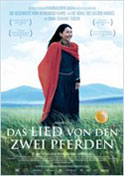

Opening 3 Jun 2010
Directed by:
Byambasuren Davaa
Writing credits:
Byambasuren Davaa
Urna, the charismatic Mongolian singer, is the main protagonist. She undertakes an arduous journey through her homeland of Mongolia to fulfil a promise to her grandmother. The antique violin (“Pferdekopfgeige”, horse head violin) which belonged to her grandmother must be restored, but only the horse’s beautifully carved head and long neck had survived. The body of the instrument was destroyed during the Chinese Cultural Revolution.
Ulaan Baatar, an ugly “modern” city with hastily built high-rises, is her first stop. She visits Hichengui, who can still build a violin in the traditional way. From here she starts her trip into the interior in search of an old song about the great hero Genghis Khan. The Song of the Two Horses was first mentioned in writing during the 12th century and had been sung by her grandmother. A few words are engraved on the remains of the violin, which is known as a Morin Chuur. Patiently she asks many people, but nobody remembers the words of the old song. When taking a mini bus into isolated areas of the nomads, the bus gets stuck in the mud, and she continues by foot. A friendly couple gives her shelter in their tent, suggesting joining a nearby wedding party where many old people will be present. But again, none of the guests know the song.
Despite her many disappointments, the dedicated, determined young woman keeps searching, calling on a shaman, galloping through the wide steppe and climbing a mountain. An old woman meditating on top of a hill is her last hope. Urna’s search for the old melody is also a search for her own roots, for her own identity and the identity of her people whose traditions had been destroyed during years of Russian and Chinese rule.
Director Byambasuren Davaa (also script and production), was born in Ulaan Baatar but studied in Germany. Die Geschichte vom weinenden Kamel (The Story of the Crying Camel, 2003) and the children’s film Die Höhle des gelben Hundes (The Cave of the Yellow Dog, 2004/2004) received numerous prizes.
Her newest documentary is very different from the two previous films. It is a calm, slow-moving story concentrating on the Mongolian singer Urna Chahar Tugchi and her interpretation of traditional music. She is an internationally known singer who has performed at festivals in Europe where she fascinated audiences with her expressive voice. At first this music might not always be appreciated by western ears. The song genre which is known as Long Song has very drawn-out sounds, and a song of ten words can take up to four minutes. In Eastern Mongolia the songs are often accompanied by the Morin Chuur, but in Western Mongolia the singer traditionally performs without instruments. I feel it is an important film for lovers of folklore. It shows an effort of preserving the musical history of a people.
In 2003 the music of the Morin Chuur(“Pferdekopfgeige”) was added to the UNESCO list of Immaterial World Heritage. (Birgit Schrumpf)